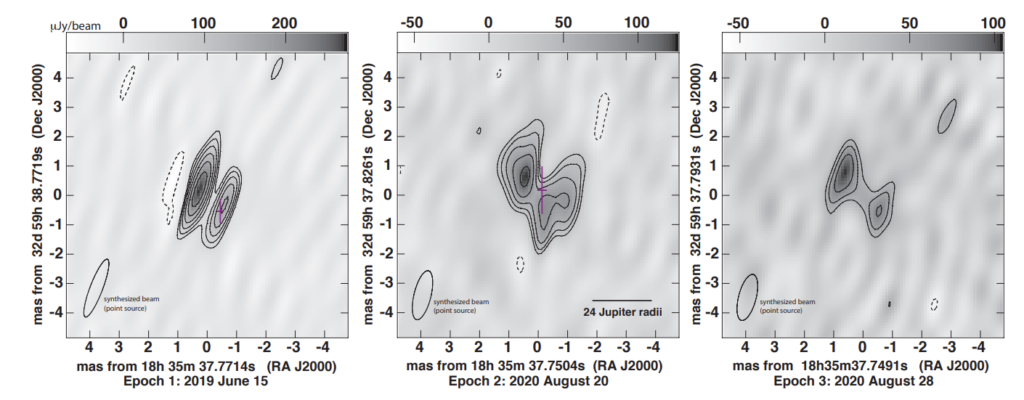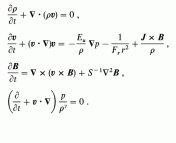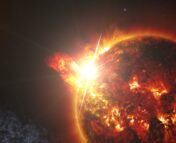Title: Resolved imaging of an extrasolar radiation belt around an ultracool dwarf
Authors: Melodie M. Kao, Amy J. Mioduszewski, Jackie Villadsen, Evgenya L. Shkolnik
First Author’s Institution: Department of Astronomy & Astrophysics, University of California, Santa Cruz
Status: Submitted to Springer Nature

If aliens were looking at our solar system for radio emission as signs of life, the planet they’d most likely see is Jupiter. When observing at frequencies below 40 MHz, Jupiter’s electron cyclotron maser (ECM) emission makes it the brightest object in our sky– even brighter than the Sun! At GHz frequencies, electrons trapped by Jupiter’s magnetic field produce synchrotron emission in a region called a radiation belt, as shown in Figure 1. Actually, all magnetized planets in our solar system have radiation belts– Earth’s radiation belt is more commonly called the Van Allen belt. In this paper, Kao et al present the first possible detection of an exosolar– meaning outside of our solar system– equivalent of these radiation belts. However, instead of surrounding a planet, this belt is found around an ultracool dwarf, or UCD.
The Ultracool Dwarf
The UCD these authors looked at is LSRJ1835+3259 (called J1835 here). Weighing in at ~80 times Jupiter’s mass, J1835 sits at the cusp of “very small star” and “very large brown dwarf”. Despite its small stature, this object hosts a ~3 kiloGauss (kG) magnetic field– ~3,000 times the Sun’s field strength! With such a strong field, J1835 has a menagerie of magnetic marvels. Not only does it have periodic radio bursts associated with ECM (like Jupiter’s 40 MHz emission), but it also has emission lines that likely originate from aurorae. Usually a corona or chromosphere is responsible for producing emission lines on stars. This is peculiar– although J1835 has been classified as an M8.5 dwarf star (about as small as you can be and still considered a star), its emission resembles that of Jupiter more than that of a star. Does this object represent a transition between planet-like to star-like activity?
The Ultra Cool Observation
To investigate this question, the authors looked for 8.4GHz radio emission from J1835 with the High Sensitivity Array (HSA), a very-long-baseline interferometry instrument. The large distance between the light-collecting elements of the array (as much as 10,000 km) gives this instrument a resolution as high as a few tenths of a milliarcsecond– as observed from Earth, this would be sufficient to resolve a cat on the moon! With such a high resolution, the authors were able to tell what the shape of J1835’s radio emission looked like, even though it’s more than 300,000 times further away from us than Jupiter is. In particular, they find J1835 has a lobe of radio emission on each side of it, separated from each other by about 18 times J1835’s radius, as shown in Figure 2. This shape is similar to what we see from Jupiter’s radiation belt.

The Ultra Cool Science
Shapes are well and good, but how do the authors figure out what is responsible for producing the emission? This requires that we assume J1835’s magnetic field, rather than collisions in thermal emission, is the dominant accelerator of charged particles. This is reasonable to assume given how strong the field is. When the field dominates acceleration and emission, the cyclotron frequency, which depends on the magnetic field strength, is the relevant emission frequency. Since we know the field strength of J1835, we can use information from the cyclotron frequency to determine the other properties that affect the emission, namely, the energy of the electrons.
Now, although J1835’s surface field strength is ~3 kG, at the distance from its surface where the emission is originating, the field would only be about 2 G. The cyclotron frequency for a 2 G field is only ~6 MHz– three orders of magnitude smaller than the 8.4 GHz emission seen with the HSA. Instead, what was likely observed is very high harmonics– integer multiples– of the cyclotron frequency. This can happen when the emitting electrons are exceptionally energetic. To produce emission at 8.4 GHz, these electrons must be moving at more than 99.9% the speed of light! These speeds are characteristic of electrons producing synchrotron radiation, and the energy associated with these electrons would not be much higher than the electrons responsible for Jupiter’s synchrotron emission.
Also much like Jupiter’s synchrotron emission from its radiation belt, J1835’s emission is persistent. The authors conducted three observations that spanned a year– and the structure was detected every time! The shape, type, and persistence of the emission all make the authors confident that what they observed is in fact an exosolar analog of the radiation belts we see in our own solar system. This represents a huge step in understanding how magnetic fields vary with stellar type and can inform us how the mechanisms for producing these fields might vary as well. This is a great step towards understanding what makes a star a star– and what might make everything else not one!
Astrobite edited by Emma Clarke
Featured image adapted from Chuck Carter, Gregg Hallinan/Caltech, and Fernando Pandha




